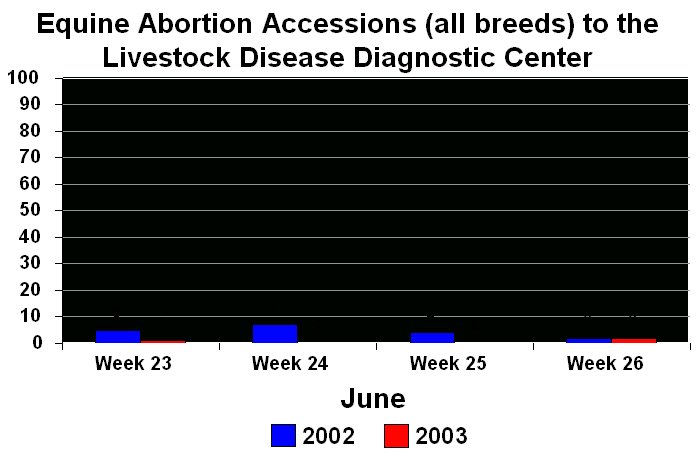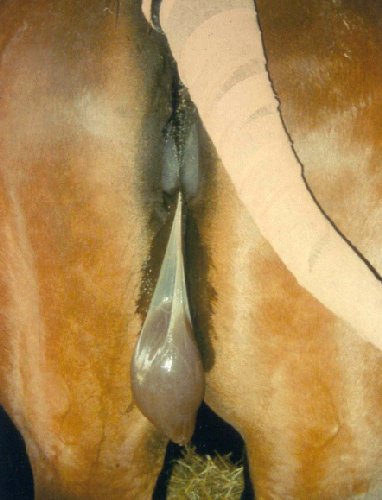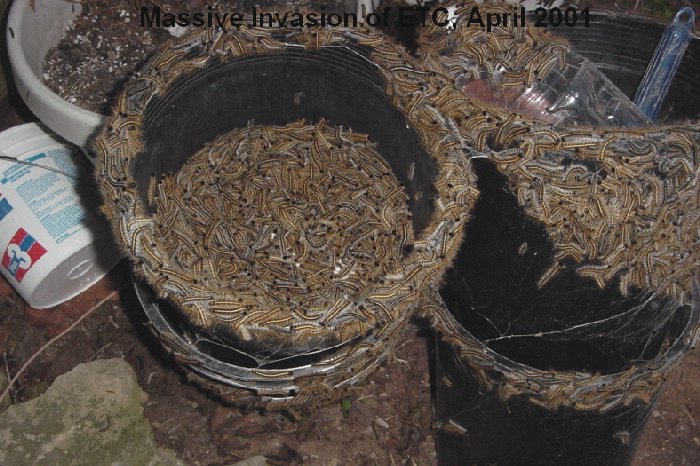Reproduction: mare reproductive loss syndrome
Synonym(s): MRLS, fetal loss syndrome
Introduction
- During April and May of 2001 and 2002 the pregnant mare population of central Kentucky in the USA, comprising multiple breeds of horses, experienced a high level of fetal loss

 .
. - Cause: with no immediate explanation for the cause it was identified as Mare Reproductive Loss Syndrome (MRLS). Exposure to the eastern tent caterpillar (ETC), the larval form of Malacosoma americanum during April and May has been identified, based on field and experimental studies, as the principal source for the development of MRLS in horses.
- Signs: early fetal loss (EFL), late term abortions and birth of weak foals collectively referred to as late fetal loss (LFL), unilateral endophthalmitis and pericarditis in the general equine population of the area.
- Diagnosis: a combination of clinical, epidemiological and pathological observations within an affected population, with affected populations typically being affected by EFL. LFL, birth of weak foals with acute respiratory distress, fibrinous pericarditis, and unilateral and acute onset exudative endo-ophthalmitis (though not all of these presentations necessarily occur in any one affected population).
- Treatment: no effective treatment reported for mares showing ultrasonographic signs of EFL. Empirical treatment and intensive nursing care of weak neonates. Cases of pericarditis may be treated with pericardiocentesis, repeated if necessary, and corticosteroids and antibiotics. Cases of endophthalmitis reported not to respond to treatment.
- Prognosis: unfavorable.
Presenting signs
- EFL Abortion: early embryonic / fetal death: mare history generally indicates no premonitory signs.
- LFL: abortion in the late stage of pregnancy
 , the birth of weak foals with acute respiratory distress.
, the birth of weak foals with acute respiratory distress. - Unilateral endophthalmitis Eye: panophthalmitis.
- Pericarditis Heart: pericarditis.
Geographic incidence
- In the USA:
- Kentucky (2001-2002).
- Also seen in Ohio, Pennsylvania and West Virginia and Tennessee (2001-2002).
- Florida and New Jersey (2006).
- In Australia (2004) an abortion storm in mares associated with exposure to caterpillars was reported, which shared some features with MRLS.
Age predisposition
- All ages of horse susceptible to endophthalmitis and pericarditis.
Breed/Species predisposition
- Multiple breeds, including Thoroughbreds Thoroughbred.
Public health considerations
- To date, no hazards to public health have been identified.
Cost considerations
- A study undertaken by the Department of Equine Business at the University of Louisville, USA (summer of 2001), estimated the economic loss to the equine industry of Kentucky, over a four-year period 2000-3003, at $336 million (293 million Euros / £203 million).
- Subsequent losses in 2002 would raise that figure to approximately $500 million (436 million Euros / £303 million).
Pathogenesis
Etiology
- Preliminary observations in 2001 indicated that reproductive losses occurred simultaneously over a wide area of central Kentucky on many farms commencing in the latter part of April. This observation was more indicative of an environmental toxin as distinct from an infectious agent.
- Studies to identify possible toxins included mycotoxins, fungal endophytes, phytoestrogens and chemical compounds all gave negative results.
- At the present time the exact etiology of MRLS has not been determined.
- Experimental studies undertaken by scientists at the University of Kentucky during 2003 suggest that the factor from ETC giving rise to abortion is present in or on the exoskeleton.
- Another study demonstrated that irradiated ETC (which would destroy infectious agents carried by caterpillars) could induce fetal loss in late-term pregnant mares.
- One hypothesis is that MRLS is caused by an ETC-related toxin, with secondary opportunistic bacterial invasion of the fetus.
- Al alternative hypothesis is that MRLS is caused by the hairs of the caterpillar breaching gastrointestinal mucosal integrity, thus allowing opportunistic bacteria access to the bloodstream, and resulting in bacteremia.
- The majority of bacteria found in cases of MRLS are non-hemolytic Streptococcus spp and Actinobacillus spp.
Predisposing factors
General
- Bacterial infection in cases of EFL and LFL represent an ante mortem event and most pathological lesions could be attributable to bacterial infection.
- However, epidemiological findings and bacterial isolation suggest a secondary role for bacteria. Bacteria gain access to the amniotic fluid and sites with direct contact with this fluid but show little tendency to invade.
- The high incidence of red bag syndrome suggests premature placental separation indicative of placental damage.
Timecourse
- Field and experimental studies indicate the onset of both EFL and LFL following exposure to ETC is rapid, a matter of days, whereas the onset of endophthalmitis and pericarditis is more protracted.
Epidemiology
- An extensive epidemiological study undertaken in the summer of 2001 on 133 farms in central Kentucky identified high to medium levels of ETC and cherry trees as strongly associated with a high incidence of MRLS.
- Field and experimental studies in 2002 confirmed the role of the ETC.
- The overwintered eggs of the insect hatch in the early spring over a 3 week period that is influenced by an increase in mean daily temperatures. In Kentucky, this coincides with about 50% bloom of Forsythia occurring in late March and early April.
- The emerging larvae
 (caterpillars) build a communal silk shelter (tents)
(caterpillars) build a communal silk shelter (tents)  which are visible in tree branches through the months of April and May.
which are visible in tree branches through the months of April and May. - ETC are ravenous feeders and when present in massive population densities
 (as occurred in Kentucky in 2001) rapidly defoliate their natal tree before falling to the ground in search of another food source. It was during this period (late April to early May) that horses in Kentucky were exposed to caterpillars in 2001 and 2002.
(as occurred in Kentucky in 2001) rapidly defoliate their natal tree before falling to the ground in search of another food source. It was during this period (late April to early May) that horses in Kentucky were exposed to caterpillars in 2001 and 2002.
Diagnosis
Subscribe To View
This article is available to subscribers.
Try a free trial today or contact us for more information.
Treatment
Subscribe To View
This article is available to subscribers.
Try a free trial today or contact us for more information.
Prevention
Subscribe To View
This article is available to subscribers.
Try a free trial today or contact us for more information.
Outcomes
Subscribe To View
This article is available to subscribers.
Try a free trial today or contact us for more information.
Further Reading
Publications
Refereed papers
- Recent references from PubMed and VetMedResource.
- McDowell K J et al (2010) Invited review: the role of caterpillars in mare reproductive loss sydrome: a model for environmental causes of abortion. J Anim Sci 88 (4), 1379-1387 PubMed.
- Sebastian M M et al (2008) Review paper: mare reproductive loss syndrome. Vet Pathol 45 (5), 710-722 PubMed.
- Volkmann D et al (2008) Hormone profiles of mares affected by the mare reproductive loss syndrome. Repro Dom Anim 43 (5), 578-583 PubMed.
- Potter D A, Foss L, Baumler R E & Held D W (2005) Managing Eastern tent caterpillars Malacosoma americanum (F) on horse farms to reduce risk of mare reproductive loss syndrome. Pest Management Sci 61 (1), 3-15 PubMed.
- Cohen N D, Carey V J et al (2003) Case-control study of late-term abortions associated with mare reproductive loss syndrome in central Kentucky. JAVMA 222 (2), 199-209 PubMed.
- Cohen N D, Carey V J et al (2003) Descriptive epidemiology of late-term abortions associated with the mare reproductive loss syndrome in central Kentucky. J Vet Diag Invest 15 (3), 295-297 PubMed.
- Cohen N D, Donahue J G et al (2003) Case-control study of early-term abortions (early fetal losses) associated with mare reproductive loss syndrome in central Kentucky. JAVMA 222 (2), 210-217 PubMed.
- Dwyer R M (2003) Fitting the pieces of the puzzle: mare reproductive loss syndrome update. Equine Vet Educ (American Edition) 5 (1), 56-58 VetMedResource.
- Dwyer R M, Garber L P et al (2003) Case-control study of factors associated with excessive proportions of early fetal losses associated with mare reproductive loss syndrome in central Kentucky during 2001. JAVMA 222 (5), 613-619 PubMed.
- Hughes C, Lehner F et al (2003) A simple and highly sensitive spectrophotometric method for the determination of cyanide in equine blood. Toxicol Mech Methods 13 (2), 129-138 PubMed.
- Fitzgerald T D, Jeffers P M & Mantella D (2002) Depletion of host derived cyanide in the gut of the eastern tent caterpillar, Malacosoma americanum. J Chem Ecology 28 (2), 257-268 PubMed.
- Morehead J P, Blanchard T L, Thompson J A & Brinsko S P (200